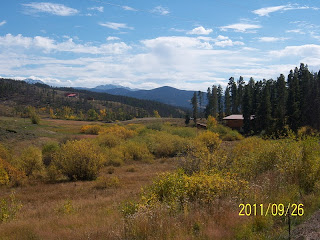Aspen are able to survive forest fires since their roots are below the heat of the fire, with new sprouts growing after the fire burns out. Aspen have an increased popularity up here after loosing millions of pine trees to the beetle. Aspen have a fast growth rate and ability to regenerate from sprouts.
We enjoy all the beautiful show of colors as leaves change each autumn. Did you ever wonder how this happens. Leaves change colour because they need a break, a winter of rest, after a summer of photosynthesizing (using sunlight to convert water and carbon dioxide into sugar).
Aspen are native to cold regions with cool summers. All of the aspens typically grow in clonal colonies derived from a single seedling, and spreading by means of root suckers; new stems in the colony may appear up to 3-40 meters from the parent tree.
An aspen tree can live for 40-150 years above ground, but the root system of the colony is long-lived, thousands of years, sending up new trunks as the older trunks die off above ground. The aspen is considered to be an indicator of ancient woodlands. A colony in Utah, "Pando"is claimed to be 80,000 years old.
Pigments are responsible for the distinct colours of the leaves in the fall; chlorophyll for green, carotenoid for yellow, orange and brown; anthocyanins for red. As sunlight decreases, the tree stops producing chlorophyll and the carotenoid in the leaves shows through with yellows, oranges and soft browns.
In contrast with many trees, aspen bark is base-rich, meaning that aspens are important hosts for and act as food plants for the larvae of butterfly species, seasonal forage for the hare and other animals in early spring. Aspen bark provides an extra food source for elk and deer in winter.
Standing trees seem to rot from the heart outward, the dry timber weathers very well, becoming silvery-grey and resistant to rotting and warping. Aspen makes beautiful paneling and sauna interiors.
What causes the most spectacular display? The brightest colors are seen when the late summer is dry, and autumn has bright sunny days and cool nights (low 40's*). A fall with cloudy days and warm nights bring drab colors. Sunny days and cool nights produce choicest spectrum
Fun Trivia!
Aspen have been traditionally reputed in many countries to drive off evil spirits, planted near the dwellings. An aspen stake was believed to be one of the few weapons suitable to kill a vampire or a werewolf. According to the Ute legend, the reason for the unique aspect of aspen quaking happened during a visit from the Great Spirit during the full moon. All of nature anticipated the Spirit's arrival and trembled to pay homage, all except the proud and beautiful aspen. The aspen stood still, refusing to pay proper respect. The Great Spirit was furious and and decreed that, from that time on, the aspen leaves would tremble whenever anyone looked upon them. There are many other legends of the quaking aspen - that I won't mention now.
 |
| Aspen wood is white and soft, but fairly strong, and has low flammability. It is used to make matches among a number of uses. |
 |
In admiration of fall's splendour, John Donne once wrote, "No spring nor summer beauty hath such grace, as I have seen in one autumnal face." You don't have to be an English poet to appreciate the season's bright colours and bountiful harvest, which help smooth the transition to shorter and colder days.
 |

















No comments:
Post a Comment